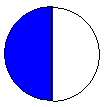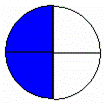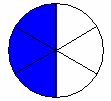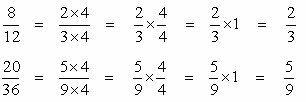Fractions
Equivalent Fractions
Two fractions are considered equivalent if in their simplest form (lowest terms) they are the same. Equivalent fractions have the same overall value. Consider the following example:
 |
 |
 |
The three fractions above all have different numerators and denominators, but As the three figures demonstrate, they represent the same fraction of the figure, one half. All three fractions reduce to one-half so they are equivalent fractions.
Find Equivalent Fractions
There are two types of problems involving equivalents that you will likely see.
- Comparing two fractions to determine whether or not they are equivalent.
- Finding an equivalent fraction with a specific denominator.
Comparing Fractions
We know that equivalent fractions reduce to the same fraction in their simplest form. Suppose we wanted to know whether two fractions were equivalent as in the following example.
Example: Tell whether the following pairs of fractions are equivalent.


To make this determination, we must reduce each fraction to lowest terms. If necessary, follow the link below to review how we reduce fractions to smallest terms.
Review Reduce Fractions to Lowest Terms
So we reduce the pairs to lowest terms:


We can see that the fractions in the first example are equivalent since they reduce to the same simple fraction. However, the fractions in the second example are not equivalent because in their simplest form they represent two different fractions and therefore, have different overall values.
Practice: Determine whether the pairs are equivalent fractions.




Practice: Determine whether the fraction is in lowest terms. If not, simplify to lowest terms.


